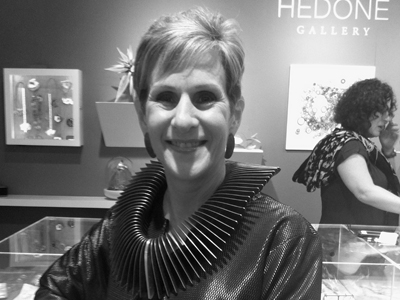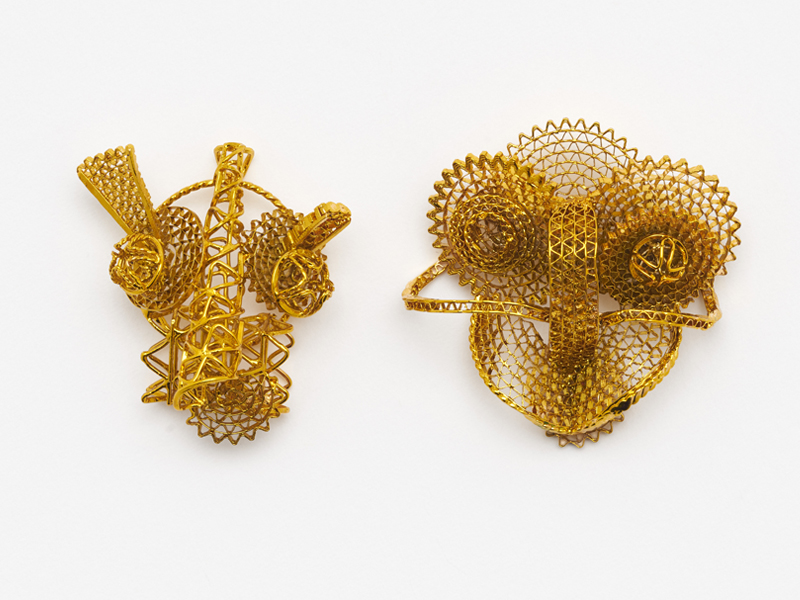
Renowned Australian goldsmith Robert Baines is an artist-goldsmith, scholar, and commentator on the field of contemporary crafts. He has won numerous international awards and, in 2010, was named a Living Treasure: Master of Australian Craft. On the eve of his new exhibition, Perceptions, at Gallery Loupe, we caught up with him to learn more about his research, his work—past and present—and his point of view on the field of contemporary jewelry.
Bonnie Levine: I’ve been fascinated learning about you and your work for this interview. Your practice is multifaceted: award-winning maker, noted scholar, art historian, professor emeritus, and critic. Tell us about your background and how you got started making intricate, complex structures.
Robert Baines: Since childhood I have been drawn to intricacy and complexity and had a wonder of fragility. A spiritual consciousness of how jewelry can be art has slowly developed to the realization that making jewelry is a spiritual action and becomes an incarnation when there is the rendering of the invisible idea into a materialized visible object. Embarking on orthodox jewelry manufacture was a door opened onto a more personal strategy of working.
Your scholarly research was in the areas of artist goldsmithing and archaeometallurgy. What does archaeometallurgy encompass, and how did you become interested in the traditions of jewelry and its origins?
Robert Baines: Jewelry is not only adornment but also a cultural, archaeological, and technological document. Technology applied by the ancient goldsmith leaves characteristic traces investigated by archaeometallurgy. Archaeometallurgy was the investigation into the manufacture of Greek jewelry in the High Classical Era and that quite often stylistic configurations are the consequence of technical factors confronting the ancient goldsmith. The Metropolitan Museum of Art encouraged me to test this theoretical position over a number of years by making copies of pieces in their collection and testing them. This has developed my understandings that jewelry artifact crystallizes “human drama” and this knowledge base has empowered my trajectory into playing with jewelry history and applying a contemporary relevance to it.
As a researcher, you became an expert on authenticity and spotting fakes in museum collections. In fact, I’ve read you can re-create a piece of jewelry that is virtually identical to the original. Meanwhile, you have also produced faux historical work (notably, the Java-La-Grande bracelet). Do you consider the past to be one of your materials? And when do forgeries become creative gestures?
Robert Baines: Making laboratory reconstructions or accurate copies of historical jewelry brings insight and a deep learning of process. This new knowledge is informing of the museum collection and it provides a knowledge base for the authentication of historic jewelry works. It was at this point I first considered the question, “Is it important to have an authentic material cultural history?” This led me to constructing stories that were either true or fictitious and providing the material evidence that they were true.
Jewelry artifacts as bogus evidence is steeped in authentic material science and curatorial methodologies. The goldsmith can play or twist these orthodox analyses and findings to the point that the viewer who has been informed along the way says, no, it cannot be true.
Inclusion of the bogus into that which is accepted as the standard or primary reference can be subversive. Forgers are crooks, deceivers, and charlatans, but what they put forward becomes informing, entertaining, and sometimes just laughable.
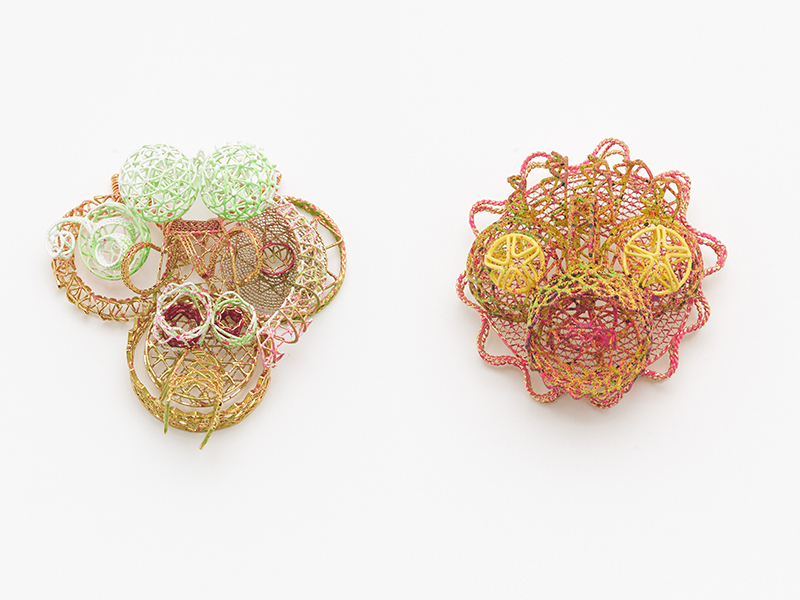
Your work references elements of Australian culture and draws from a variety of foreign cultural sources. Some commentators have criticized the effect of global communication on this field, and worry about the emergence of an international style with no perceptible roots. How do you feel about that?
Robert Baines: I do like to pursue an Australian context in my stories and then provide jewelry evidence for it. A different more political thinking was John Williamson’s song “True Blue,” in which he laments over the demise of an earlier authentic cultural history in Australia.
I am not interested in the global and leave that imbroglio to its own rapacity. Robert Hughes, when asked how he saw the future of art, remarked, “I am not a prophet but I see a rush to insignificance.” That is what I see largely in contemporary jewelry. Building jewelry has the nature of spiritual choices without assurance and a confronting uncertainty in making art continues. I have had the view for a long time that my work has to be positioned where it can be challenged universally and in showing it can be contested internationally.
You are, among other things, a scholar of metallurgy. This aspect of your practice is very present in your talks and catalog. How has your scholarly research and the history of jewelry influenced your body of work? Don’t you think there is a tension between the goals of science and those of art?
Robert Baines: Broadly I have made pieces that manifest a chosen subject. A fundamental condition is that jewelry captures human drama and in that is a wealth of possibilities. There is an endeavor to build a contemporary statement referencing cultural history. There are dangers in this strategy as the work could be hastily dismissed because of its seeming preoccupation with historicity.
My primary interest is in the history of the goldsmith and the artifact that makes it manifest. This basically starts with Bronze Age gold technology and the jewelry meanings over that broad period of Greek Gold of the High Classical Era (which includes the Etruscan period in particular). Subsequent jewelry histories have their wonder and offer abundant potential subjects to “play with.” Historical jewelry is a social and political document that is available to research, reinterpret, and question its authenticity.
It can be confounding to look for a scientific explanation. I am interested in the human drama within certain cultures as subject. My book More Amazing Schmuck… was a jewelry commentary about popular culture, e.g., Paris Hilton. The book Fabulous Follies, Frauds and Fakes includes the stories “The Official History of the Compact Disc” and “Armbandits.” The latter is a jewelry account of how a gold 11th-century Islamic armband influenced design history to the point it turns out as an Iced VoVo (an Australian sweet biscuit). So these are “low” and “high” culture subjects, but I would like to emphasize that I am increasingly pursuing a statement of high art in my jewelry. The endeavor is to achieve using scientific practices to bring an excellence, originality, and unique personal statement in jewelry artifact. Modernism does allow sampling, playing with history, and using combinations of base and precious materials together. I think it is appropriate during these times to play with authenticity and ask, Is it important?
Art jewelry cannot be completely free of context. Every material or process has an embedded material cultural history. The goldsmith can’t escape that history, but nor should it be a burden, a conundrum, or an obstacle to making original statements. New contexts can be invented and illustrated with fictitious evidence. Historic or contemporary contexts of human drama are available to be subverted using the jewelry artifact to convey contextual meanings. Jewelry is the vehicle.

In the 90s, you started experimenting with wire and continue to use this material in your jewelry today. Why wire? Can you do things with it that are not possible with other materials?
Robert Baines: My jewelry constructs are built entirely of line. It is a binary world where space is more predominant than mass and this is a metaphysical place to work within. Rhythm is wire and space, wire is the line, line measures space, line captures space, line is the meter of poetry, line is the poetry of matter, space is the matter of poetry, does poetry matter? Wire networks comprise planar surfaces of variable patterning, with a repetition of line and space. This creates a poësis (poetics of making).
Having chosen the direction of building linear structures to convey subject, my premise in the making is to expand the possibilities of options. This means that quite often time is spent just exploring technical factors quite devoid of subject or concept. There is an ongoing effort to build a finesse in linear structures. Building a complexity from my own constructed vocabulary is a primary consideration rather than choosing from readymade solutions.
The last part of your question implies a physical engagement with other materials where there is some sort of technical virtuosity. The answer is yes. All materials have their own potentiality and can convey symbology. Wire as line has its own uniqueness and eccentricity.
Your pieces are very technical, complex and intricate—and yet also share the visual playfulness of, say, Calder’s work, particularly in the recent series. Is this contrasting combination something that defines your approach?
Robert Baines: Making jewelry is with the brain and secondly with the hands—it’s a game. I am not sure about “playfulness.” Some have said they see humor in the work but that is not my intention. I see it as serious business with multiple considerations.
Color seems to be important in your work, especially red, which recurs throughout different collections. Red is an interesting paradox, signifying power, anger, and aggression but also love and affection. In fact, you’ve said that red is not a color—“it’s the condition of red.” What do you mean by that?
Robert Baines: AAA,AAA,AA…REDEVENT, a series I began working on in 1994, initially comprised of eight jewelry subjects that are imbued with reverence. I decided to extend the meaning of these works by using red. Applying a coloured symbology. Not confining red to its color but the structures manifest the varying conditions of red. The conveying of love and sacrifice in the vehicle of red has antecedents since time immemorial. Within all the substances to convey red is the enjoyment of entropy and on its ultimate state of degeneration the symbol becomes quiescent. The fullness of red remains untold.
Not confining red to its color, but to the condition of red, has many possibilities of meaning such as emotion, love, hate, anger, affection, danger, forgiveness. Many of my pieces that followed were red. This became tiresome. It was a release to use other colors and still talk about the “condition” of red.
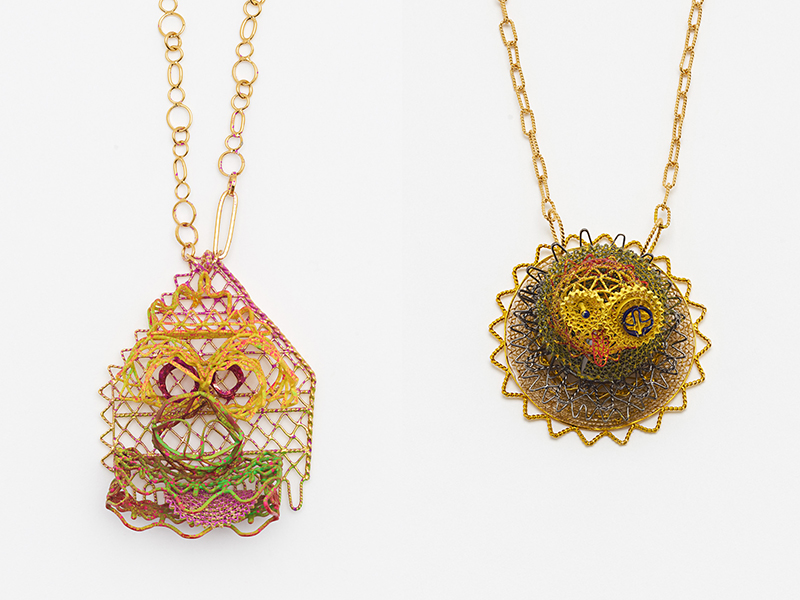
In your current exhibition at Gallery Loupe, Perceptions, I see something different every time I look at a piece. Is it a face, a mask, a caricature, a portrait—I’m not really sure. Is this intentional? What do you want viewers to take away from your work? What inspired this collection?
Robert Baines: Unfortunately these are not my words and the writer of the exhibition announcement has developed a condition of conjecture about what the work means and this is misleading. My source and premise to this work is quite different. It is based on the question of the Psalmist to the creator God: “What is man that thou art mindful of him?” This is enlarged upon in a beautiful quote by Salman Rushdie in The Ground Beneath Her Feet, where there is an account of the expansive experience of person: “Whenever someone who knows you disappears, you lose one version of yourself. Yourself as you were seen, as you were judged to be. Lover or enemy, mother or friend, those who know us construct us, and their several knowings slant the different facets of our characters like diamond-cutter’s tools. Each such loss is a step leading to the grave, where all versions blend and end.” Knowledge of an individual can convey multiple expressions of the singular person and I am building manifestations of these. There are distracting signals and though the jewelry is entertaining it is not the revelation of “one version of oneself.” This is to be pursued, to be looked for, and in the seeking there will be a first glimpse of the knowing and the jewelry transmission will be complete.
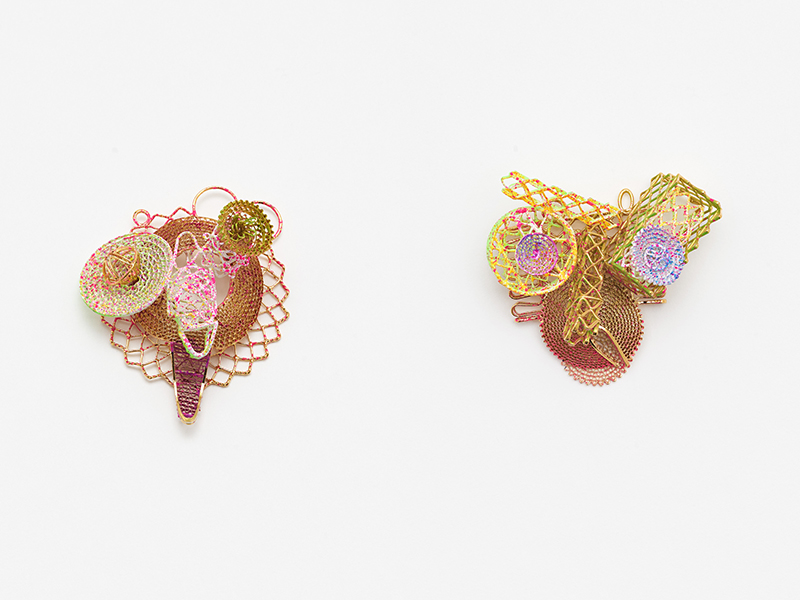
With such a long and multifaceted career, you have a unique perspective on the world of contemporary jewelry. Where would you position your own work on the broad spectrum of contemporary jewelry—art? Design? Craft? Other? If you decide to respond with, “I don’t like categories,” please tell us why you think jewelry benefits from not acknowledging differences between practices. Where do you see the field going in the future, and how do you feel about it?
Robert Baines: I don’t see myself positioned anywhere in contemporary jewelry and feel quite antithetical to the movement. It is an imbroglio laden with rampant consumerism of ideas and in the center are shysters, plagiarists, and jewelry police. On the other hand I have met and work with lovely people. I abhor the design word as much as I regard filigree as the “F” word. I think there can be integrity in craft but it is restrictive of my metaphysical pursuits in jewelry. In art jewelry expression there is an endless and marvelous freedom which can become a point of worship.
What have you seen or read lately that’s excited or inspired you that you’d like to share with our readers?
Robert Baines: Salman Rushdie, The Ground Beneath Her Feet, has recently been inspirational. The subject of “better and worse” has been an ongoing subject for consideration since 1982 and still continues with new jewelry meanings. C. S. Lewis, The Great Divorce, (Pilgrim’s Regress), Collins Fontana, 1976, page 88.
Thank you very much.

INDEX IMAGE: Robert Baines, Perception 11, 2015–2016, pendant, silver, powder coat, electroplate, 75 (with chain 405) x 75 x 40 mm, photo: Jeremy Dillon
